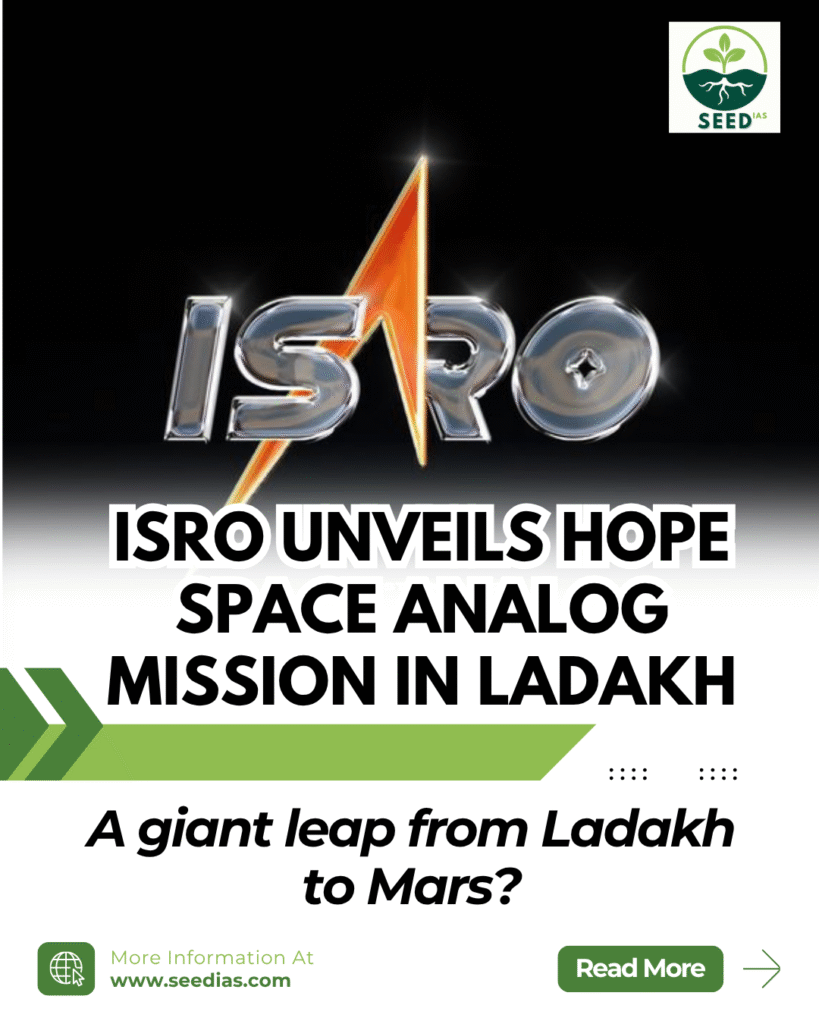Why in NEWS
The Indian Space Research Organisation (ISRO) has inaugurated the Himalayan Outpost for Planetary Exploration (HOPE) at Tso Kar Valley, Ladakh, to simulate and study challenges related to long-duration human space missions.
Key Terms / Concepts
| Term / Concept | Explanation |
|---|---|
| HOPE Mission | A space analog mission simulating space-like conditions for testing technologies and human readiness for Moon and Mars missions. |
| Space Analog | A location on Earth with environmental conditions similar to other planets, used for testing and training. |
| In-situ Resource Utilization (ISRU) | Using local resources (like soil, water, or minerals) for sustaining life or building infrastructure in space missions. |
| Tso Kar Valley | High-altitude cold desert in Ladakh, selected for its Mars-like conditions; also a Ramsar wetland site. |
Key Details
| Aspect | Details |
|---|---|
| Objective | To study physiological, psychological, and operational challenges; test health monitoring and microbial sampling techniques; and prepare for interplanetary missions. |
| Location Advantage | High UV radiation, low air pressure (40% oxygen level of sea level), extreme temperatures (15°C to -10°C), and Mars-like rocky-sandy soil. |
| Technology Testing | Life support systems, habitat technology, rover operations, and ISRU experiments. |
| Human Spaceflight Link | Supports Gaganyaan and long-term goals like an Indian lunar landing by 2040. |
Significance
| Significance Area | Details |
|---|---|
| Scientific Research | Generates vital data for interplanetary exploration, astrobiology, and habitat design. |
| Technological Readiness | Strengthens capacity to operate in hostile environments. |
| National Capability | Promotes self-reliance (Atmanirbhar) in advanced space technologies through public-private-academic collaboration. |
Earlier Analog Missions
| Mission | Location / Year | Purpose |
|---|---|---|
| Ladakh Human Analog Mission (LHAM) | Leh, 2024 | Test space habitat technology under Moon/Mars-like conditions. |
| Anugami (GANEX) | India, 2025 | 10-day human spaceflight readiness experiment. |
| Desert RATS (NASA) | Arizona Desert | Test rovers and EVA systems. |
| NEEMO (NASA) | Aquarius Undersea Station | Simulate isolation and teamwork in space-like environment. |
| HI-SEAS | Hawai‘i | Mars/Moon analog research station for habitat and crew experiments. |
In a Nutshell
Mnemonic: “HOPE LADAKH”
H – Human spaceflight readiness
O – Oxygen deficit (40% of sea level)
P – Planetary analog testing
E – Extreme temperatures (-10°C to 15°C)
L – Life support trials
A – Astrobiology studies
D – Data for Moon/Mars missions
A – Atmanirbhar space research
K – Key step for Gaganyaan & 2040 lunar goal
H – Habitat & health protocol validation
Prelims Questions
- Which of the following conditions makes Tso Kar Valley suitable for planetary analog missions?
a) High rainfall and dense vegetation
b) High UV radiation and low air pressure
c) Tropical temperatures and high humidity
d) Volcanic activity and lava fields - Which of the following is NOT an analog mission site?
a) NEEMO
b) HI-SEAS
c) Desert RATS
d) Chandrayaan Habitat Base - The HOPE Mission primarily aims to prepare for:
a) Underwater exploration
b) Interplanetary human spaceflight
c) Unmanned satellite launches
d) Atmospheric weather studies
Mains Questions
- Discuss the importance of planetary analog missions like HOPE in advancing India’s human spaceflight and interplanetary exploration ambitions. 10 Marks
- Examine the role of extreme terrestrial environments in preparing astronauts for space missions.
10 Marks
Prelims Answers & Explanations
| Q No. | Answer | Explanation |
|---|---|---|
| 1 | b | Tso Kar Valley has high UV radiation, low air pressure, extreme cold, and Mars-like soil. |
| 2 | d | Chandrayaan Habitat Base does not exist; others are real analog mission sites. |
| 3 | b | HOPE focuses on simulating conditions for Moon and Mars human space missions. |
















